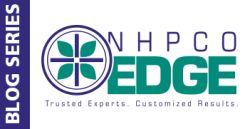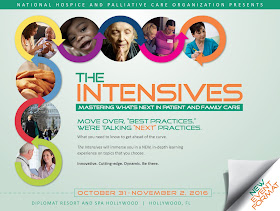Learn About Your Options…Before a Health Crisis Hits
Eight years ago, I stumbled upon the National Hospice and Palliative Care Organization. I was returning to the workforce after being at home with my younger children for two years. Although I did not know much about hospice and practically nothing about palliative care, neither was required for the position I was applying for. I began my journey here as the program assistant to the professional development department. Lots of committee work, lots of conference prep, lots of administrative tasks and tons of processing CE/CME certificates for social workers, counselors, nurses and physicians. At the time, I was more interested in the income for my family’s sake as opposed to the outcomes of work we were doing at NHPCO. I did my job and I did it well. I listened in on webinars, enjoyed meeting faculty at conferences and I have probably processed ten thousand CE/CME certificates. Fast forward to today.
Today, I am the senior manager of access programs. Over the past eight years, I have come to realize and am more aware of the work we do and its affect on patients and families. I’m also more aware of the health disparity in our field, as well. My team and I work on programs that allow patients, families and caregivers to access end-of-life care services on a national and local level through our member organizations and vice versa. NHPCO is committed to championing access to the right care at the right time for all people. Yet, the utilization of hospice and palliative care among African Americans remains disproportionately low. Of all patients utilizing hospice care in 2014, an estimated 7.6 percent were identified as black or African American, which reflects a slight drop from the previous year. Several studies have shown the reasons for underutilization range from lack of education and awareness about end-of-life care services, religious beliefs and to just not wanting to talk about the subject.
NHPCO’s strategic plan includes expanding hospice and palliative care access to African American communities where a disparity of care exists. This year through a collaboration between NHPCO and Morgan State University we have worked hard to move this initiative forward. Morgan State University is a HBCU located in Baltimore, MD. Historically Black Colleges and Universities (HBCUs) are relevant and play an essential part in today's higher education and serve as a hub for gatherings in many African American communities.
This spring, we invited Baltimore area pastors to join us for fellowship and open dialogue with Pastor Corey Kennard who provided guidance and inspiration for addressing the spiritual needs of those dealing with serious illness, end-of-life and grief within the faith community. He also touched on the effectiveness of the faith community and forming healthcare partnerships in this work. We had a great time. We learned a lot. We were also left with a lot to think about.
The meeting with the local pastors served as a “kick-off” to our 4-Week workshop series on end-of life care. During this series we offered the following free, non-credit courses:
- Faith and Hope at the End of Life
- What is Hospice and Palliative Care?
- How To Plan and Communicate Your Future Healthcare Wishes (my class!)
- Loss, Grief and Bereavement
Let’s face it, none of these subjects are “sexy” but very necessary. Making decisions by the bedside is not the right time to discuss any of these topics. Our goal is to encourage you, your family and caregivers to learn more about your options so you’ll be able to make informed decisions about end-of-life care. Imagine your mom or dad being diagnosed with a serious illness and you and your siblings, and your parent’s extended family trying to make tough decisions during a time when emotions are high. Sound familiar? I know the feeling. I’ve been there and don’t want to be there again.
So, what happened at MSU? The courses went well. Our faculty members were great. Here are a few of the many participant comments we received about the courses:
 “Thank you for this course. Information is power when dealing with myself or a loved-one’s healthcare & end of life decisions.”
“Thank you for this course. Information is power when dealing with myself or a loved-one’s healthcare & end of life decisions.”
“Very interesting, informative and educational.”
“Pastor Corey is a motivational, engaging, informed facilitator.”
“Really like the non-threating approach to difficult subject, varied methods to learning, and practical approach.”
“This course really made me think of how I can be supportive to those who are experiencing grief.”
“It was extremely amazing. I never knew so much went into hospice and that palliative care existed.”
“I’m glad I came, really informative! Both Kennedy and Coleman were great and knowledgeable about the subject.”
I even learned a little more about each subject. Who knew! I met some great folks in Baltimore. Participants were very engaged in each course; the questions were interesting. Many ideas and family stories shared.
I was blessed to be able to teach the course, How to Plan and Communicate Your Future Healthcare Wishes. This course was all about advance directives and advance care planning. I wanted to leave participants with tools they could use when talking to their families about their personal wishes, including their healthcare provider in the conversation, and choosing a fitting healthcare proxy to be his/her decision maker. Advance care planning is much more than completing an advance directive. That paper means nothing if you have not had any conversations with your healthcare providers and family. Have you explained to them who your healthcare proxy will be? Does everyone in your family have a copy? Does your healthcare provider have a copy? Have you asked your healthcare provider questions about the medical treatments you don’t understand? I covered some serious topics but also played a game and showed videos to keep it fun.
Now what? Phase II of this collaboration is taking place this fall. These courses will be offered for free to Baltimore families, caregivers and anyone interested in learning more about end-of-life care. All courses will be hosted at MSU’s University Student Center. Refreshments will be provided. Parking is available. Encourage your friends, family and neighbors to take advantage of this learning opportunity.
You can register yourself, a friend or a group for one or more of the courses. To reserve a spot, REGISTER ONLINE or call 443-885-3155. When you know better, you do better. Get the conversations started today. Attend a course, learn about your options and become your own healthcare advocate. Baby steps. If there is a topic about end-of-life care that you’d like to learn more about, mention it in the comments section of this post. I’d love to hear from you.
Special Thanks to the Infinity Hospice Foundation for providing financial support to Phase II of this collaboration.
Cozzie M. King
Senior Manager, Access Programs
Staff Liaison, NHPCO’s Diversity Advisory Council
















